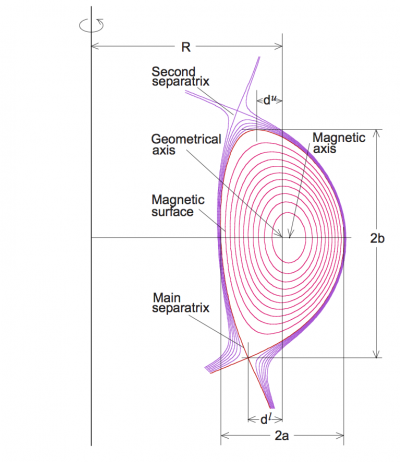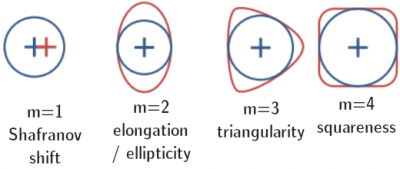Triangularity: Difference between revisions
Jump to navigation
Jump to search
(Created page with "The triangularity refers to the shape of the poloidal cross section of the Last Closed Flux surface (LCFS) or separatrix of a tokamak. Assuming: * ''R<sub>0</sub>...") |
m (Add simple illustration of shift, elongation, triangularity, and squareness) |
||
| (10 intermediate revisions by 2 users not shown) | |||
| Line 1: | Line 1: | ||
[[File:Geometry.png|400px|thumb|right|Sketch of tokamak geometry, including separatrix]] | |||
[[File:Cross_section_1shift_2elong_3triang_4square.png|400px|thumb|right|Illustration of the m=1,2,3, and 4 perturbations to a tokamak plasma cross section. Triangularity is the m=3 perturbation.]] | |||
The triangularity refers to the shape of the poloidal cross section of the Last Closed [[Flux surface]] (LCFS) or [[separatrix]] of a [[tokamak]]. | The triangularity refers to the shape of the poloidal cross section of the Last Closed [[Flux surface]] (LCFS) or [[separatrix]] of a [[tokamak]]. | ||
Assuming: | Assuming<ref>T.C. Luce, [[doi:10.1088/0741-3335/55/9/095009|Plasma Phys. Control. Fusion '''55''' (2013) 095009 ]]</ref>: | ||
* ''R<sub> | * ''R<sub>max</sub>'' is the maximum value of ''R'' along the LCFS or separatrix. | ||
* ''a'' is the minor radius of the plasma, defined as | * ''R<sub>min</sub>'' is the minimum value of ''R'' along the LCFS or separatrix. | ||
* ''R<sub> | * ''R<sub>geo</sub>'' is the geometric major radius, defined as ''(R<sub>max</sub> + R<sub>min</sub>)/2''. | ||
* ''R<sub> | * ''a'' is the minor radius of the plasma, defined as ''(R<sub>max</sub> - R<sub>min</sub>)/2''. | ||
* ''R<sub>upper</sub>'' is the major radius of the highest vertical point of the LCFS or separatrix. | |||
* ''R<sub>lower</sub>'' is the major radius of the lowest vertical point of the LCFS or separatrix. | |||
The upper triangularity is then defined as follows: | The upper triangularity is then defined as follows: | ||
:<math> \ | :<math> \delta_{upper} = (R_{geo}-R_{upper})/a</math> | ||
and similar for & | and similar for δ<sub>lower</sub>. | ||
The overall triangularity is defined as the mean of & | The overall triangularity is defined as the mean of δ<sub>upper</sub> and δ<sub>lower</sub>. | ||
Triangularity, especially the triangularity opposite the dominant X-point (so upper triangularity for a lower null plasma), influences the stability and character of the [[pedestal]] and [[Edge Localized Modes|ELMs]].<ref>[[doi:10.1088/0741-3335/42/5A/319|T.H. Osborne, et al., Plasma Phys. Control. Fusion '''42''' (2000) A175]]</ref> | |||
Some devices (TCV and DIII-D) can form plasma cross sections with negative triangularity (the X-points are pushed to larger <math>R</math> than the center of the plasma), which makes H-mode difficult or impossible to access but improves performance of the L-mode.<ref>[[doi:10.1088/1741-4326/abdb95|W. Han, et al., Nucl. Fusion '''61''' (2021) 034003]]</ref> | |||
== See also == | == See also == | ||
* [[Ellipticity]] | * [[Ellipticity]] | ||
* [[Toroidal coordinates]] | |||
* [[Effective plasma radius]] | |||
== References == | |||
<references /> | |||
Latest revision as of 23:50, 30 March 2023
The triangularity refers to the shape of the poloidal cross section of the Last Closed Flux surface (LCFS) or separatrix of a tokamak. Assuming[1]:
- Rmax is the maximum value of R along the LCFS or separatrix.
- Rmin is the minimum value of R along the LCFS or separatrix.
- Rgeo is the geometric major radius, defined as (Rmax + Rmin)/2.
- a is the minor radius of the plasma, defined as (Rmax - Rmin)/2.
- Rupper is the major radius of the highest vertical point of the LCFS or separatrix.
- Rlower is the major radius of the lowest vertical point of the LCFS or separatrix.
The upper triangularity is then defined as follows:
and similar for δlower. The overall triangularity is defined as the mean of δupper and δlower.
Triangularity, especially the triangularity opposite the dominant X-point (so upper triangularity for a lower null plasma), influences the stability and character of the pedestal and ELMs.[2]
Some devices (TCV and DIII-D) can form plasma cross sections with negative triangularity (the X-points are pushed to larger than the center of the plasma), which makes H-mode difficult or impossible to access but improves performance of the L-mode.[3]



